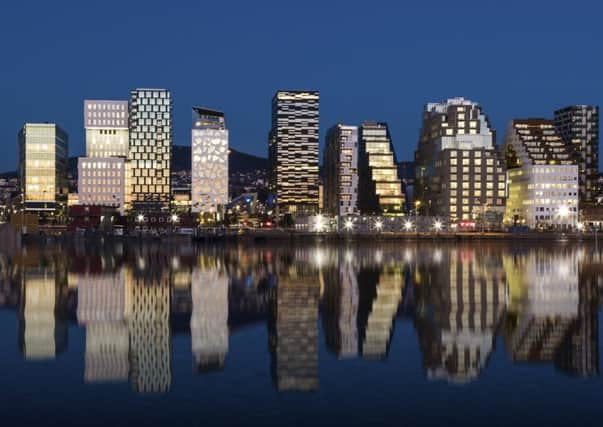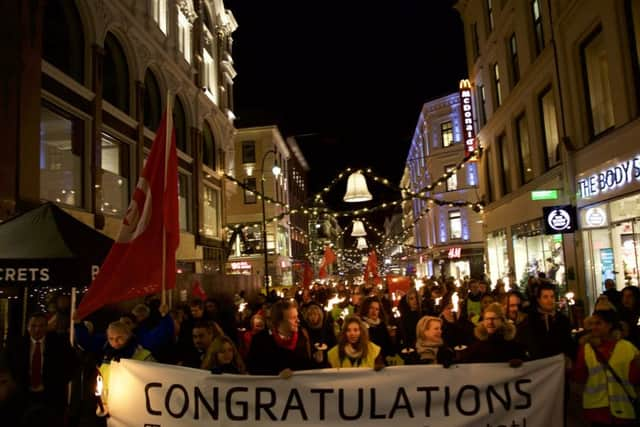Travel: Oslo, home of the Nobel Prize, is a top cultural destination


Cheering, chanting political slogans, men dancing, groups of women making celebratory high-pitched ululatory trilling noises, babies’ prams draped with Tunisian flags – the torchlight parade making its way up Oslo’s exclusive Karl Johans gate in a bitterly cold winter’s evening last December was like no other.
This was a march of thousands of people – Tunisian, Norwegian, and from countries around the world to honour the winners of the 2015 Nobel Peace Prize awarded in Norway’s capital city on 10 December every year. The recipients, the four members of the Tunisian National Dialogue Quartet – a lawyer, a trade unionist, a business leader and a human rights activist – brokered a peaceful constitution in 2013 pulling their country back from civil war following the Jasmine Revolution, thus ensuring Tunisia kept democracy and the Arab Spring alive in the country where it started.
Advertisement
Hide AdThe Peace Prize was established by Swedish industrialist Dr Alfred Nobel (1833-1896), famed for inventing dynamite. Nobel was extremely shocked when he read in a French newspaper, which mistakenly thought he, not his brother, had died, that “the merchant of death is dead”.


He resolved to secure a more worthy legacy by setting up the Nobel Peace Prize to be awarded by Norway, which was already promoting peaceful politics, while the other prizes – including physics, chemistry and literature – were to be staged in his homeland.
As well as the torchlight parade, tourists travelling to Oslo during the Peace Prize week can buy tickets in advance for the Nobel Peace Prize Concert at the Telenor Arena. The 2015 concert, attended by the Nobel Peace Prize winners and members of the Norwegian Royal family, was hosted by US television frontman Jay Leno, whose jokes included digs at the Kardashians and Donald Trump.
Performers included Norwegian band A-Ha; electronic dance superstar Kygo; international hip-hop artist Jason Derulo; pop-punk singer Mø, 19-year-old Norwegian singer-songwriter Aurora; and Emel Mathlouthi, the Tunisian singer-songwriter whose songs became anthems for the Tunisian revolution.
Visitors can also enjoy the Nobel Peace Centre with its exhibitions and cafe, or go on guided tours of the nearby Rådhus, or City Hall, where the Peace Prize is awarded. The interior of the strikingly austere Rådhus is decorated with huge murals depicting scenes such as the city’s shipbuilding and maritime history and Norwegian resistance fighters defeating the Nazis.


Both the Rådhus and the Nobel Peace Centre are on the Aker Brygge on the city’s waterfront, with its breathtakingly beautiful view of the Oslo Fjord. There is a good choice of cafes and restaurants to enjoy seasonal Nordic food and watch the world go by. Tables outdoors have lanterns on them constantly lit to brighten the winter days, while the seats are covered in sheepskin rugs and blankets to keep customers cosy.
Advertisement
Hide AdOne excellent stopping place is Restaurant Louise, which is decorated with maritime paintings and antiques and serves wonderful Nordic cuisine.
From the Aker Brygge, a former shipyard, it is only a ten-minute ferry trip (or bus if preferred) to the Bygdøy peninsula, with its choice of museums. These include the world-famous Viking Ship Museum, with burial artefacts from boat graves around the Oslo Fjord; the Fram museum, which houses famous Norwegian explorer Fridtjof Nansen’s polar sailing ship Fram; the Kon-Tiki Museum, with Thor Heyerdahl’s Kon Tiki raft on which he sailed to Polynesia, and Ra 11, a craft which made the journey to Barbados; the Norwegian Folk Museum, with a range of genuine farm buildings across the centuries which were dismantled plank by plank and rebuilt on site; and the Maritime Museum of boat-building history.
Advertisement
Hide AdThe best way to get around the city is to buy an Oslo Pass, which gives unlimited use of public transport and entry to more than 30 museums, as well as a range of benefits including free walking tours, entry to swimming pools and discounts and special offers in many restaurants, shops and leisure venues.
Transport links from Oslo Airport Gardermoen to the city’s main railway station are straightforward. The “Silver Bullet” departs every ten minutes and takes around 20 minutes to arrive at Oslo central station right in the centre of the city.
No visit to Oslo would be complete without seeing The Scream (1893), Norwegian artist Edvard Munch’s most renowned work, on show in The National Gallery behind-reinforced glass. A later version (1910) by the artist – who did not like parting with his work – is in the Munch Museum.
Today, Oslo’s art world is in a state of change, with building work underway to create a new National Museum of Art, Architecture and Design, located behind the Nobel Peace Centre with a public access rooftop space looking out on to the Oslo Fjord. But the massive white “shoe box” structure has divided opinion, with some describing it as Brutalist. Supporters criticise the current old-fashioned Night At The Museum nature of the current National Museum. They claim the new building, due to open in 2020, will better showcase the city’s art and attract a wider range of visitors “even if just to enjoy a beer on the roof terrace before working up courage to visit the gallery or go to an exhibition for the first time”.
If you want to see a contrasting side to Oslo’s waterfront and city centre, a visit to the up-and-coming Grünerløkka district is to be recommended.
Formerly home to a good number of the city’s working-class population, the once-gritty, overcrowded, properties, some with outside toilets, underwent redevelopment in the 1990s and the area is now seeing a resurgence and attracting many students and families with young children. At its centre is a grassy square surrounded by good value cafes, restaurants and vintage shops, and the scene of picnics in the summer. At the very heart of the district is Parkteatret, a converted cinema, established in 1907 which is now a popular venue for local and international bands.
Advertisement
Hide AdA further attraction is Mathallen, a large indoor food market selling local produce which is proving to be a popular meeting place for new parents with their babies.
A comfortable and stylish base for a trip to the city is First Hotel Grims Grenka in Kongens gate, just off the main Karl Johans gate, in the shadow of the famous Akershus Fortress.
Advertisement
Hide AdThe hotel has 65 rooms and 17 sumptuous suites, as well as the acclaimed Madu restaurant. Madu is famed for its Nordic cuisine, such as its starters of smoked Minke whale with tarragon mayonnaise and rye bread chips, and main courses including reindeer with baked beets, cream of dates and port wine broth. A favourite dessert with locals and tourists alike is the Grims Grenka Kvaefjord cake, a traditional offering from northern Norway with red whortleberries, usually served with cream but altered to organic blue cheese.
But you don’t have to be a Peace Prize winner to go to Oslo in winter – the city is a prize in itself.
• Norwegian (www.norwegian.com) flies from Edinburgh to Oslo from £44.90 one way. Rooms at First Hotel Grims Grenka start from £118 for a double or twin room (www.firsthotels.no/grimsgrenka)